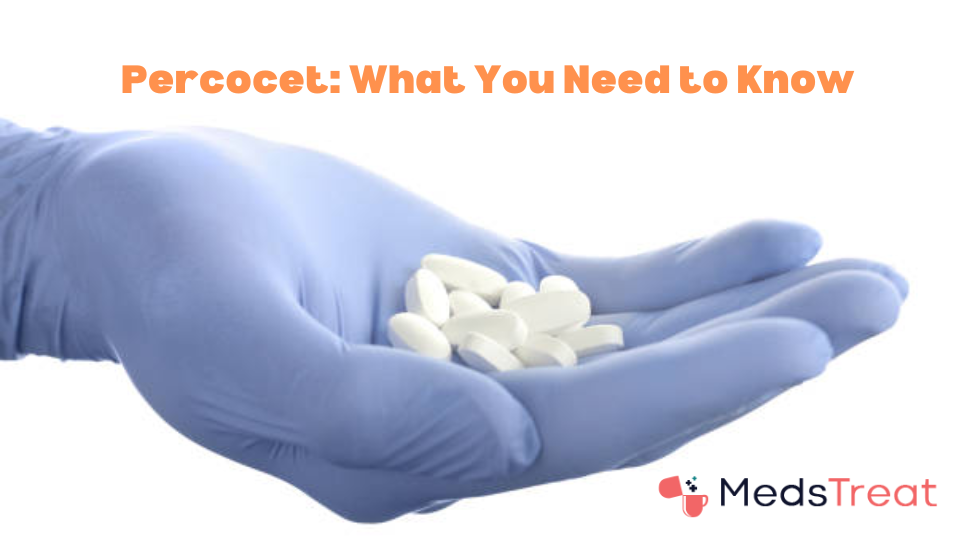Introduction
It is a prescription medication that combines oxycodone, a potent opioid pain reliever, and acetaminophen, a non-opioid pain reliever and fever reducer. This powerful combination is often prescribed to manage moderate to acute pain, such as that experienced after surgery or due to chronic conditions. However, the use of Percocet is not without risks, as it belongs to the opioid class of medications, which has been associated with dependence and addiction.
In the further lines, we will explore the various aspects of it , including its medical uses, chemical composition, legal status, potential side effects, risk of dependence, withdrawal, and detoxification, as well as alternative therapies and the importance of patient education. If you are about to order Percocet online, these details will help you to choose if It is a reliable option for you or not. To dive into the depth of the topic, keep reading.
Medical uses
Here are some medical uses of Percocet:
Pain Relief: It is primarily prescribed to manage moderate to severe pain. It is often used after surgery, injury, or for chronic pain conditions where other painkillers may not be effective.
Post-Surgical Pain: It is commonly prescribed to alleviate pain following surgical procedures, such as orthopedic surgeries or dental procedures.
Chronic Pain Conditions: For certain chronic pain conditions, where non-opioid medications alone may not provide sufficient relief, it may be prescribed under close medical supervision.
It’s important to note that while It can be helpful in managing pain, it also carries the risk of dependence and addiction, mainly if not used as directed by a healthcare expert. Due to the opioid component (oxycodone), there is a potential for abuse and misuse. If you order Percocet online, you should also follow your healthcare expert’s instructions.
Chemical Composition
Percocet is a combination medication that contains two active ingredients with distinct chemical compositions:
Oxycodone Hydrochloride: This is the opioid component of Percocet. Oxycodone is a semi-synthetic opioid analgesic, and its chemical name is derived from codeine. Percocet drug binds to opioid receptors in the CNS, producing pain relief and, in some cases, a sense of euphoria. The hydrochloride form, oxycodone hydrochloride, is the salt form of oxycodone commonly used in medications.
Acetaminophen (Paracetamol): This is the non-opioid component of Percocet. Acetaminophen is a widely used OTC painkiller and fever reducer. It works by inhibiting the synthesis of certain chemical messengers (prostaglandins) in the brain that contribute to pain and fever. Acetaminophen is also known as paracetamol in some parts of the world.
The combination of acetaminophen and oxycodone in Percocet offers a more comprehensive approach to pain management, as they target pain through different mechanisms. Oxycodone addresses pain through its opioid receptor activity, while acetaminophen provides additional pain relief and reduces fever.
Prescription and Legal Status
Percocet is a prescription medication, meaning it cannot be legally obtained without a valid prescription from a licensed healthcare expert. It is a controlled substance due to its opioid component, oxycodone, which has the potential for abuse and dependence. The legal status of Percocet is subject to the regulations and laws of individual countries. In the United States, for example, Percocet is classified as a Schedule II controlled substance under the CSA or Controlled Substances Act.
This classification is due to the presence of oxycodone, which is considered to have a high potential for abuse. Key points regarding the prescription and legal status of Percocet include:
Prescription Required: A healthcare expert, typically a doctor, must prescribe Percocet. The prescription will include specific instructions regarding dosage, frequency, and duration of use.
Controlled Substance: Percocet is classified as a controlled substance because it contains an opioid. This classification is meant to regulate its distribution, use, and prescribing to minimize the potential for abuse and dependence.
Regulations and Monitoring: Due to the opioid epidemic and concerns about misuse, healthcare experts and pharmacists are subject to strict regulations and monitoring when prescribing and dispensing medications like Percocet.
If you want to buy real Percocet online at an affordable price, you may visit our e-pharmacy website. We provide top-quality medicines at affordable rates.
Potential Side Effects
You should get urgent clinical help if you have signs of an allergic reaction to this drug, such as difficulty breathing, hives, or swelling of your body parts.
In a few vases, acetaminophen can cause an acute skin reaction that may be fatal. It could happen even if you have used Tylenol or acetaminophen in the past and had no reaction.
You should stop using Percocet and contact your healthcare expert immediately if you have skin rash or redness that spreads and causes peeling and blistering.
Contact your healthcare expert immediately if you have-
- Clammy, cold skin, seizure
- Tiredness, weakness, fever
- Week pulse or slow heartbeat
- Issues with urination, seizure
Severe breathing issues can be more likely in older people and those who are debilitated or have chronic breathing disorders or wasting syndrome. If you are looking on search engines- [Percocet near me], you can visit our e-pharmacy website. Here, we provide Percocet for sale, and you may also get exclusive discounts on all medicines, including Percocet.
Long-term usage of opioids can impact fertility in women or men.
Common side effects of Percocet-
- Headache, nausea, constipation
- Red eye, itching, flushing
- Stomach ache, blurred vision, dry mouth
Rare side effects-
- Hoarseness, cough
- Sore throat, ulcers
- Unusual bruising or bleeding
Along with these, you can see other different side effects of this drug. You must be cautious after you buy Percocet online.
Risk of Dependence and Addiction
Percocet contains oxycodone, an opioid analgesic, which comes with a risk of dependence and addiction. Understanding these risks is crucial for both healthcare experts and patients:
Dependence: Dependence refers to the body’s adaptation to the presence of a drug. With regular use of opioids like Percocet, the body can become tolerant, requiring higher doses over time to obtain the same level of pain relief. Dependence may lead to withdrawal symptoms if the drug is suddenly stopped or the dosage is reduced.
Addiction: Addiction is a chronic, relapsing disorder characterized by compulsive drug-seeking, continued use despite harmful consequences, and long-lasting changes in the brain. People may develop psychological cravings for Percocet, and the drug may become a central focus in their lives. Addiction is a severe medical condition that needs professional intervention.
Withdrawal and Detoxification
Withdrawal from opioids like Percocet can be challenging, and it’s essential to approach it with proper medical supervision. Withdrawal symptoms can be uncomfortable and, in a few cases, severe. Abruptly stopping opioid use, mainly after prolonged or high-dose exposure, can lead to withdrawal symptoms.
It’s crucial for people who want to discontinue Percocet or any opioid medication to do so under the guidance of a healthcare expert. Here are some key points about withdrawal and detoxification from Percocet:
Symptoms of Withdrawal: Withdrawal symptoms from opioids like Percocet can include nausea, vomiting, diarrhea, muscle aches, anxiety, insomnia, sweating, and irritability. The severity and duration of withdrawal symptoms may vary based on factors such as the person’s level of dependence and the duration of opioid use.
Tapering Off:
Gradual Reduction: Tapering off Percocet under the guidance of a healthcare provider is a common approach. This involves gradually reducing the dosage over a specified period to minimize withdrawal symptoms.
Individualized Plans: Tapering plans should be individualized based on the patient’s needs, medical history, and response to the tapering process.
Medical Supervision: Withdrawal and detoxification should be conducted under the supervision of a healthcare expert, such as a doctor or addiction specialist. This allows for monitoring symptoms and adjustments to the tapering plan as needed.
Supportive Care: Supportive measures may be employed to manage specific withdrawal symptoms. For example, medications may be used to alleviate nausea, diarrhea, or anxiety.
Detoxification Programs: In a few cases, individuals may enter detoxification programs to manage withdrawal symptoms in a controlled environment. These programs may provide additional support and counseling.
Transition to Non-Opioid Pain Management: For people using Percocet for pain management, a healthcare provider can help transition to alternative, non-opioid pain management strategies.
It’s crucial for people to communicate openly with their healthcare experts about their desire to discontinue Percocet and follow the recommended tapering plan. Abruptly stopping opioids without proper medical guidance can be associated with risks and an increased likelihood of relapse.
If you want to get Percocet drug at a discounted price, you can visit our e-pharmacy website. We provide top-quality medicines at discounted prices.
Alternatives and Complementary Therapies
When managing pain or considering alternatives to medicines like Percocet, healthcare experts often explore various options tailored to an individual’s specific condition and needs. Here are some alternatives and complementary therapies that may be considered:
Non-Opioid Pain Medications:
NSAIDs: These drugs, such as naproxen or ibuprofen, can be effective for certain types of pain and have anti-inflammatory properties.
Acetaminophen (Tylenol): While it is a component of Percocet, acetaminophen can be used alone for pain relief without the opioid component.
Physical Therapy:
Exercise and Stretching: Tailored exercise programs and stretching routines designed by physical therapists can help manage and prevent pain.
Manual Therapy: Techniques like massage and manipulation by a physical therapist can be beneficial.
Cognitive-Behavioral Therapy (CBT): CBT is a form of psychotherapy that helps people manage pain by addressing thoughts, emotions, and behaviors related to pain. It’s essential for people to work closely with their healthcare experts to determine the most appropriate combination of therapies for their specific situation.
Patient Education and Awareness
Educating people about the benefits and risks of Percocet is vital. It helps promote responsible use and prevent complications. If you are about to buy Percocet online, you should be aware of the possible side effects, signs of dependence, and the importance of the prescribed dosage.
Healthcare experts should also engage in open communication with patients, addressing any concerns or queries they may have about Percocet or alternative pain management options. Patient awareness extends beyond the individual, involving discussions within communities about the dangers of opioid misuse and the importance of proper pain management. Community education programs can contribute to reducing the stigma associated with seeking help for pain-related issues and addiction.
Conclusion
I hope you find this blog informative and interesting. This blog was all about Percocet, which is an effective painkiller. You can get several benefits if you buy real Percocet online from a reliable pharmacy store. We have mentioned all the essential facts, such as medical uses, chemical composition, withdrawal and detoxification, and side effects. These facts may help you to decide if this drug is suitable for you or not.
FAQ’s
How should Percocet be stored?
It should be stored in a secure place, away from children and pets. Follow the specific storage instructions provided by the pharmacist, and do not use the medication after the expiration date.
Can Percocet be habit-forming?
Yes, It has the potential for dependence and addiction, mainly if used improperly or for extended periods. Follow your healthcare expert’s instructions closely, and do not suddenly stop taking the drug without consulting them.
Can Percocet be prescribed for long-term use?
In general, opioids like it is typically prescribed for short-term pain management. Prolonged use may require close monitoring and adjustments to the treatment plan. You should consult your healthcare expert for guidance on long-term use.
Can I consume alcohol while taking Percocet?
It is advisable to avoid alcohol while taking Percocet, as it may enhance the sedative effects of the medication and increase the risk of side effects and complications.

